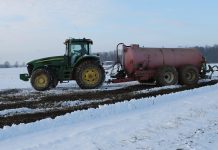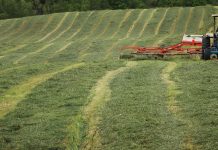I have received several calls lately about designs and sizing of bunker silos for dairy operations. Farm managers are always concerned with sizing of the structures in order to control spoilage on the silage face during feed-out.
We generally recommend removing at least 4 inches of silage off the entire silage face daily during hot summer weather. This parameter is the most important factor influencing the size of bunker silos for small to medium dairy herds.
Several other factors are important in designing bunker silos, including adequate access for filling, adequate space for unloading equipment, and provisions for access to silage during bad weather. Proper drainage in and around bunker silos is critical to maintaining high quality feed as well as protecting water quality in and around the dairy operation.
Eye on the environment. Silage leachate is an environmental problem on many farms. Leachate control systems should be part of the design of all new silos, whether the silo is a bunker or a tower, and must be an integral part of the complete water quality control system for the facility.
Information and suggestions for dealing with these concerns are contained in Natural Resource, Agriculture, and Engineering Service (NRAES) Publication 95, “Environmental Factors to Consider When Expanding Dairies,” by Peter Wright, and A. Edward Staehr.
Silage effluent or juice can have a pH of 4, a five-day biochemical oxygen demand of 12,000 to 90,000 milligrams per liter, and an ammonia level of 700 milligrams per liter. It can also have high nutrient values for nitrogen, phosphorus, and potassium.
These high concentrations of biochemical oxygen demand, acid, and ammonia in the juice cause septic odors, vegetation burn and fish kills.
Varying patterns. Tower silos produce silage juice during and immediately after filling. On the other hand, bunkers can produce juices during the entire year because rainfall is added continuously. Silage storage in plastic bags can produce effluent when the bags are opened.
The amount of effluent produced depends on several factors, including moisture content of the silage, amount of precipitation and resultant runoff from the site.
It is important to design a system to contain all runoff from the bunker silo, loading aprons, and surrounding areas. All rainfall that does not fall directly on the bunker and apron areas should be diverted away from the site to reduce the amount of contaminated water that must be contained and treated.
Control moisture. The best way to reduce the amount of leachate from silos, both tower and bunker as well as bags, is to control the moisture content of silage at ensiling. The moisture contents that produce the best quality silage in a bunk (68-70 percent) do not produce much leachate.
The following table shows the amount of leachate produced by haylage at various moisture levels in a bunker.
Annual effluent production from bunk silos
% Moisture Gallons per ton
of haylage
80 20
75 5
70 0
The amount of leachate from silage is also influenced by the amount of pressure on the silage (depth of the pile). The size of silage particles and the speed of filling may affect the rate of effluent production, but may not have much effect on the total amount.
Some cornfields in northeast Ohio may already have advanced below the optimum moisture level for proper fermentation in a bunker. Be sure to check the moisture content of corn and hay crops regularly during silo filling.
Besides these concerns about reducing silage effluent, moisture content at ensiling is the single most important factor in silage quality.
Preventing spoilage of silage is important, both from a production as well as the environmental point of view. Nutrient losses in spoiled silage may end up in leachate from the site. Piles of spoiled silage, just like piles of manure, are unattractive, contribute to odors, serve as fly breeding sites and may add to a water quality problem.
Control leachate. Silage leachate needs to be contained and then field spread. Storage tanks of quarter-inch steel, fiberglass and concrete have been used to contain effluent. The acid effluent will attack corrodible materials.
Epoxy-coated concrete and steel tanks with walls thicker than 3/8 of an inch will last longer than regular concrete and thinner-walled steel tanks.
All buried storage tanks must be designed to withstand earth loading, traffic weight and buoyancy forces. Safety measures need to be undertaken to ensure that people will not fall into storage tanks or enter them without an air supply.
The easiest way to handle silage effluent is to add it to the manure storage on the farm. This will dilute it and allow it to be spread at acceptable rates so that the nutrients can be recycled safely through crops without undue risk of environmental damage.
When diverting silage effluent into manure storage systems, add one cubic foot of additional storage capacity for each ton of silage when planning and constructing the manure storage.
May increase gasses. Adding silage effluent to the manure storage will increase microbial activity in the manure storage by increasing the energy available for microbes. This may result in an increase in the amount of gasses and odors produced.
Most open air manure storage facilities will not be significantly affected by the addition of concentrated silage effluent. However, addition of silage effluent to enclosed storage facilities may result in increased production of objectionable odors and/or dangerous gases.
Clean water from off-site runoff and ground water seepage must be excluded from bunker silos. It is essential that adequate drainage be installed to exclude off-site runoff and groundwater seepage from silage effluent.
Two separate systems will be required: one to control the groundwater and one to collect the silage juice.
Collecting all dirty runoff from a bunk silo is possible, but the amount of storage needed is usually unreasonable, since all the rainfall that runs off needs to be stored.
Grass filter area. Rainwater dilutes the silage juice. The higher volume but lower concentration pollutants may be treated in a grass filter area or constructed wetland. Allowing rainfall-driven higher flows to bypass the storage system can reduce the volume of storage needed for concentrated effluent and still protect the environment.
The effluent collection system must retain solids that float and settle. It is important to stop any solids from leaving the bunk during rainfall runoff. These solids will rot and produce silage juice.
Retained solids must be frequently cleaned out of collection basins and other areas where runoff water flows. Large runoff events have carried silage long distances and caused significant pollution.
The collection method for low flows should be adjustable, since the amount of concentrated leachate varies. Collected leachate can be stored, pumped and spread separately or added to the manure storage.
The large volume “clean” flows must still be treated in a grass waterway or filter strip to allow filtration, absorption, and biological treatment, and to allow the manager to view the effect the high flows have on the grass while the flows are still on the farm. The manager can minimize the amount of leachate stored as long as the grass in the filter strip is not hurt. Thriving grass in the filter strip is a biological indicator of adequate pollution control.
A typical leachate collection installation is shown in the accompanying figure. It can be adapted to a variety of situations. On some critical sites, all the effluent may need to be stored.
Be sure to contact your local Soil and Water Conservation District conservationist for assistance in siting and design of manure and waste water handling systems. Cost share funds may be available to help pay for such systems through your local Farm Service Agency.
(The author is an agricultural extension agent in Columbiana County. Questions or comments can be sent in care of Farm and Dairy, P.O. Box 38, Salem, OH 44460.)












